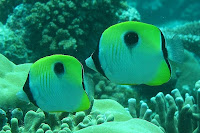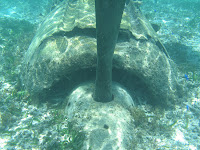 |
| Sabi Star, Suka, Shibui and Creola at South Dock |
The island of Peleliu lies in Micronesia some 500 miles east of the Philippines and is part of the Palau group. Four vessels (Creola, 49’ Hylas, Bill and Linda McKeever, California, Sabi Star, a One-Off 45’ steel sloop, Ian and Christine Grimmett, Australia, Jo Charman and Torsten Klug, Shibui, Norseman 447, sloop, Brian and Mary Alice O’Neill, Washington and Suka, CT 41’ ketch, Doug and Deb Burnsworth, Florida), departed Koror, Palau, negotiated the numerous reefs of the lagoon, passed through the narrow and shallow German Channel and entered the South Dock anchorage of Peleliu on the required high tide. Limited swing room made a stern anchor necessary in a depth of ten feet with sandy bottom. Accompanying the group were Steve and Casandra Ballinger, Directors of Cleared Ground (an English, non-profit, demining company), and daughter, Kayleigh. We had come to dive the reefs and walls, explore the WW II battleground and test the local attitude toward cruising yachts.
 |
| The Cruising Gang and Cleared Ground Land Rover |
The South Dock was constructed by the US Sea Bees following WW II. Sock-shaped, the west-facing shallow entrance cuts through Orange Beach, site of the US Marine amphibious landing in 1944, and turns south into a small bay with decaying steel jetties jutting from the jungle-lined shore. A dock with a concrete shade structure, known as Camp Beck, lies on the north shore of the entrance and serves as a lunch-stop for the many dive and tour boats that frequent the island. Roads, some dirt, some paved, snake into the dense jungle growth and disappear. Land transport is an issue on Peleliu for there are no vendors at Camp Beck or at the North Dock, which is not navigable by sailboat: no cars, no bicycles or motorcycles to be rented to facilitate the exploration of this eight mile long, crab-claw-shaped island. Tours, however, can be arranged in advance with several tour groups. The Cleared Ground Land Rover became our transport. Focused on the removal of WW II mines, bombs, grenades, mortars and bullets, Steve and Casandra have been on Peleliu for a year and their knowledge of the island’s recent history and Japanese defenses runs deep.
 |
| 1st Marine Memorial |
Diving had to wait, as we visited memorials to the military personnel who died in the battle of Peleliu. We climbed the 127 steps to the US Army Memorial on the tallest peak of Bloody Nose Ridge and watched the sunset over Death Valley, scene of an intense battle some sixty-five years ago. On a flat ledge the size of football field,a small, four-sided obelisk and a flagless pole commemorate the contributions of the First Marine Division who made the amphibious landing on the beaches, while a large and elaborate blue Shinto shrine stands some feet away as a remembrance to the followers of the Japanese emperor. The retired Marine Vietnam veteran in our group had little to say.
Imagining the Peleliu landscape in 1944-45 is difficult. All vegetation had been blasted and burned away leaving only the sharp limestone outcroppings that make up the ridge and hundreds of natural and Japanese-made caves that were constructed in the thirty years of Japanese occupation prior to WW II.
 |
| The jungle at Peleliu today |
Ten thousand Japanese soldiers defended the island in a battle that US leaders thought would take three days, but ultimately required several months and large numbers of casualties. We were led through the twists and turns of Bloody Nose Ridge and through the cave and sink-hole riddled Death Valley. Mortars, unexploded bombs and relics of the battle lay strewn along the path. Exploring caves that have been mostly cleared of ordinance, booby-traps and picric acid, we began to experience the life of a Japanese soldier. Littered with Saki bottles, the caves still contain bones, rusted helmets, canteens, Shinto shrines, fuel canisters and rice bowls. We imagined the battle of Hell’s Pocket and finally entered the Last Command Post of the Japanese leadership. An eerie feeling overcame the group as we stood within the Last Command Post composed of a rough ring of multiple sixty foot high vertical spires of limestone with caves at the base. It was here that the commanders of the Japanese forces, upon defeat, committed suicide. Within this circle not an insect was heard to chirp or a bird heard to sing. Silence reigned.
 |
| Oriental Sweelips |
It is only a short dinghy ride from South Dock to the reef along Orange Beach. At slack tide the four dinghies anchored safely atop the reef in seven feet of water and while some snorkeled along the surface enjoying visibility of seventy feet or so, others geared up to dive the depths. The reef is a beautiful sloping wall, filled with diverse reef fish, colorful corals, sharks, turtles, sea slugs, flatworms and 1000 pound bombs.
 |
| Photographing a 1000 pound bomb |
Four bombs had been located on previous dives and the search was on for more. Within 90 minutes a total of 20 bombs had been located, identified and marked for future removal. Subsequent dives on other days failed to find additional bombs, but left the divers with a profound sense of the beauty of the reef, the diversity of its life and spectacular clarity of the warm tropical water. Diving in Peleliu was easy and rewarding.
A return to land included visits to the bombed-out Japanese administration building, the museum and its collection of wartime memorabilia, fortified bunkers overgrown with banyan trees,
 |
| Crawling from a Japanese bunker |
abandoned tanks and amphibious troop vehicles, gun positions and more caves, including the 1000 man cave. This cave, which has now been cleared of ordinance by Cleared Ground, included a Japanese hospital with operating room, a command post and the final hiding place for fifty Japanese soldiers.
 |
| Clearing the 1000 Man Cave |
Today, bats and swiftlets fill the cave, which catacombs a limestone ridge but a stone’s throw away from the North Dock.
The people of Peleliu were friendly yet reserved. Our daily search for ice cream led us to the store at North Dock, where the proprietor was patient as our group of cruisers nearly filled her little shop and decimated her supply of Fat Boys, the local ice cream sandwich. The young granddaughter of a chief enthusiastically greeted us as we visited her village, introducing herself and pointing out the chief operating a skiploader across the road.
 |
| Des describes the landing on Orange Beach |
The staff at Dolphin Bay Resort served us a beautiful dinner and quietly accepted our rambunctious behavior, while Des, Speaker of the State Legislature and operator of a tour service, took time from a busy tour to chat with us and arrange an evening at his restaurant. The only negative experience was the pilfering of fuel from one of the dinghies while at dinner. Overall, we felt very comfortable as our explorations intersected with the daily lives of those who live on Peleliu.
 |
| Getting Ready for the Day's Trip |
On the final night at Peleliu, we gathered at Camp Beck for a pot-luck dinner. We were joined by the governor of the State of Peleliu, who welcomed us to the island. Having never been aboard a yacht, the governor was invited aboard Creola and while there asked what Peleliu might do to make visiting yachts more comfortable. Suggestions were offered and the governor most graciously took note. We are optimistic that in the days to come, cruising to Peleliu, with its humbling historic features and natural beauty, both above and below water, will become easier and we encourage the cruising community to seek it out.
 |
| Canteen Memorial along Death Valley |
Until then, we remember the sacrifices made on the island and to, next time, take our bicycles.













































